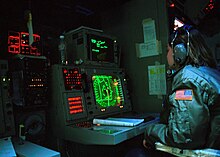
| Part of a series on |
| War (outline) |
|---|
 |
Command and control (abbr. C2) is a "set of organizational and technical attributes and processes ... [that] employs human, physical, and information resources to solve problems and accomplish missions" to achieve the goals of an organization or enterprise, according to a 2015 definition by military scientists Marius Vassiliou, David S. Alberts, and Jonathan R. Agre.[1][2] The term often refers to a military system.
Versions of the United States Army Field Manual 3-0 circulated circa 1999 define C2 in a military organization as the exercise of authority and direction by a properly designated commanding officer over assigned and attached forces in the accomplishment of a mission.[3][4]
A 1988 NATO definition is that command and control is the exercise of authority and direction by a properly designated individual over assigned resources in the accomplishment of a common goal.[5] An Australian Defence Force definition, similar to that of NATO, emphasises that C2 is the system empowering designated personnel to exercise lawful authority and direction over assigned forces for the accomplishment of missions and tasks.[6] The Australian doctrine goes on to state: "The use of agreed terminology and definitions is fundamental to any C2 system and the development of joint doctrine and procedures. The definitions in the following paragraphs have some agreement internationally, although not every potential ally will use the terms with exactly the same meaning."[6]
- ^ Vassiliou, Marius, David S. Alberts, and Jonathan R. Agre (2015). C2 Re-Envisioned: the Future of the Enterprise Archived 2 August 2019 at the Wayback Machine. CRC Press; New York; p. 1, ISBN 9781466595804.
- ^ Ross Pigeau; Carol McCann (Spring 2002). "Re-conceptualizing Command and Control" (PDF). Canadian Military Journal. 3 (1): 53–63. Archived (PDF) from the original on 20 November 2013. Retrieved 1 March 2014.
- ^ para 5-2, United States Army Field Manual: FM 3–0
Headquarters, Department of the Army (14 June 2001). FM 3–0, Operations. Washington, DC: GPO. OCLC 50597897. Archived from the original (PDF inside ZIP–SFX) on 19 February 2002. Retrieved 19 August 2013.
Newer versions of FM 3-0 Archived 4 March 2016 at the Wayback Machine do not define Command and control, even though they use the term extensively. - ^ Builder, Carl H., Bankes, Steven C., Nordin, Richard, "Command Concepts – A Theory Derived from the Practice of Command and Control" Archived 2 October 2012 at the Wayback Machine, MR775, RAND, ISBN 0-8330-2450-7, 1999
- ^ Neville Stanton; Christopher Baber; Don Harris (1 January 2008). Modelling Command and Control: Event Analysis of Systemic Teamwork. Ashgate Publishing, Ltd. ISBN 9780754670278. Archived from the original on 17 May 2016. Retrieved 15 November 2015.
- ^ a b "ADDP 00.1 Command and Control" (PDF). Commonwealth of Australia. 27 May 2009. pp. 1–2. Archived (PDF) from the original on 14 February 2014. Retrieved 1 March 2014.